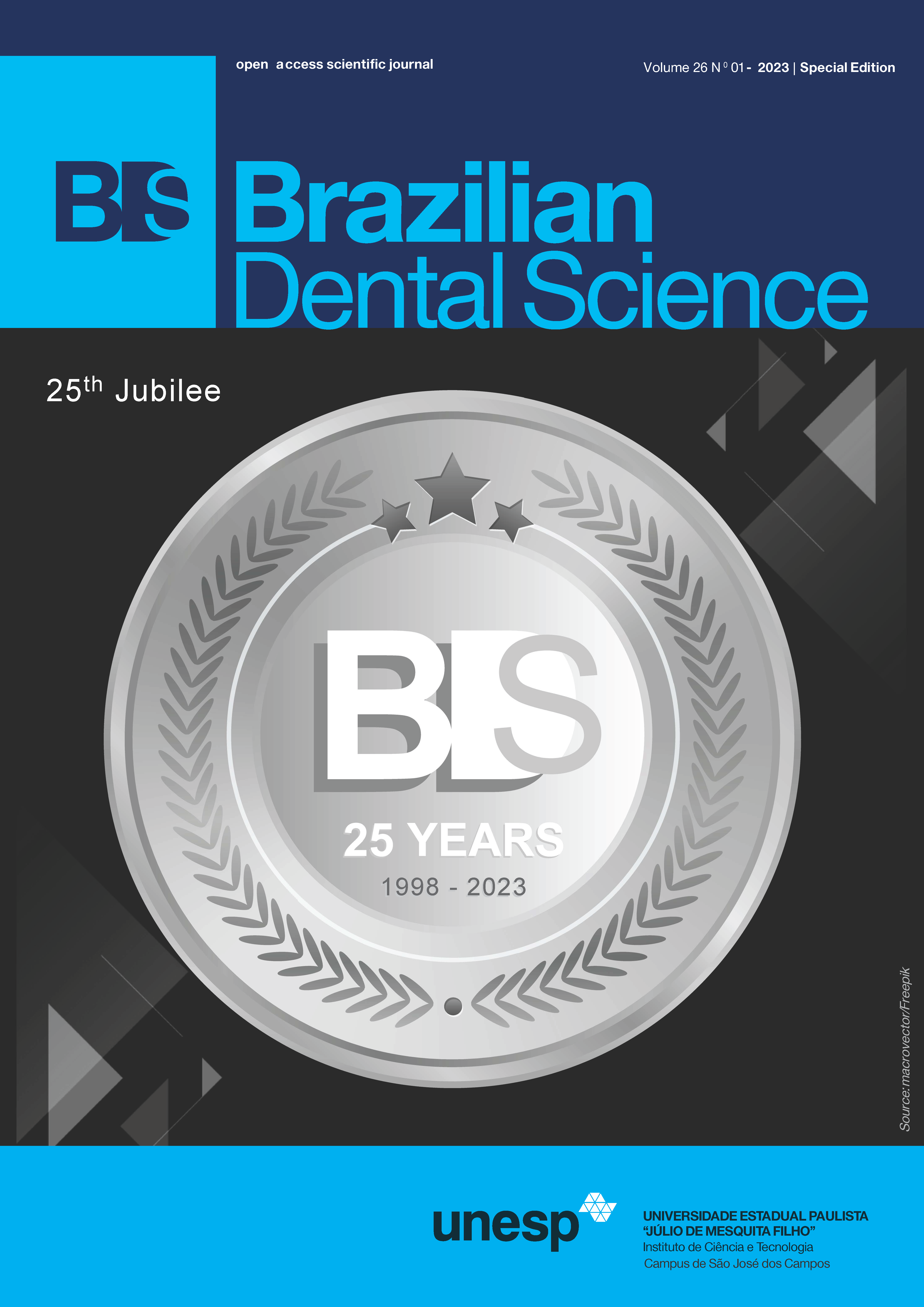UV-C light as an alternative for disinfecting orthodontic pliers
DOI:
https://doi.org/10.4322/bds.2023.e3738Abstract
Objective: Orthodontists use orthodontic pliers continuously, and these tools have a strong potential for nosocomial infections. This study aimed to compare the efficiency of three methods for disinfecting orthodontic pliers. Material and Methods: The active tips of 26 orthodontic pliers (distal end cutters and Weingart pliers) were contaminated with S. aureus, E. coli, and C. albicans microorganisms, viruses, and spores. The microbial control methods were 70% alcohol disinfection, glass bead sterilization (250 °C dry heat), and ultraviolet light irradiation (250 nm UV-C) for 30 and 60 seconds. The number of colony-forming units (CFU) and plaque-forming units (PFU) was quantified and compared for each microorganism after incubation in culture plates. Results: All tips of the pliers in the groups that received ultraviolet light or were subjected to glass bead sterilization showed a significantly lower number of spores, bacteria, and fungi than their respective control samples (p<0.001). Physical disinfection with UV-C light may represent a reliable alternative compared to other chemical and physical methods due to the increase in microorganisms resistant to chemical products and the emission of harmful by-products after chemical treatment. Conclusion: The tested microbial control methods were effective in the disinfection of orthodontic pliers, making ultraviolet-C light a promising alternative to eliminate microorganisms from pliers.
KEYWORDS
Biosafety; Contamination; Disinfection; Microorganisms; Ultraviolet light.
Downloads
Published
How to Cite
Issue
Section
License
Brazilian Dental Science uses the Creative Commons (CC-BY 4.0) license, thus preserving the integrity of articles in an open access environment. The journal allows the author to retain publishing rights without restrictions.
=================

 Ricardo Scarparo Navarro DDS MSc PhD
Licenciated in Dentistry (DDS School of Dentistry of São Paulo- University of São Paulo FOUSP) / Master Dregree in Restorative Dentistry (MSc School of Dentistry of São Paulo- University of São Paulo FOUSP) / Doctorate in Dental Sciences - area of Pediatric Dentistry (PhD School of Dentistry of São Paulo- University of São Paulo FOUSP) /
Licenciated in Lasers Applications (School of Dentistry of São Paulo- University of São Paulo FOUSP) / Licenciated in Restorative Dentistry (CFO) / Licenciated in Pediatric Dentistry (CFO) / Professor of Licenciation courses in Pediatric Dentistry and Lasers Applications at São Leopoldo Mandic Research Center and Fundecto- FOUSP / Member of IADR (International Association Dental Research) / Member IAPD (International Association of Paediatric Dentistry)
/ Member SBPqO (Dental Research Brazilian Society)
Member GBPD (Brazilian Group of Professors in Resto
rative Dentistry) / Member of ABOPED
(Brazilian Association of Paediatric Dentistry) /
Member and Advisor of ABLOS (Brazilian Association of Lasers in Dentistry and Heath) /
Member of Editorial Board of Brazilian Dental Science Journal /
Member of Human Research Ethical Comittee at University Brazil /
Professor Undergraduation Course in Dentistry at Universidade Brasil; /
Professor and Researcher of the Graduation Program in Bioengineering and Biomedical Engineering at University Brazil /
Researcher in Dental Materials, Restorative Dentistry, Paediatric Dentistry, Cariology, Phototerapy (Lasers and LEDs) in Dentistry and Health;
Ricardo Scarparo Navarro DDS MSc PhD
Licenciated in Dentistry (DDS School of Dentistry of São Paulo- University of São Paulo FOUSP) / Master Dregree in Restorative Dentistry (MSc School of Dentistry of São Paulo- University of São Paulo FOUSP) / Doctorate in Dental Sciences - area of Pediatric Dentistry (PhD School of Dentistry of São Paulo- University of São Paulo FOUSP) /
Licenciated in Lasers Applications (School of Dentistry of São Paulo- University of São Paulo FOUSP) / Licenciated in Restorative Dentistry (CFO) / Licenciated in Pediatric Dentistry (CFO) / Professor of Licenciation courses in Pediatric Dentistry and Lasers Applications at São Leopoldo Mandic Research Center and Fundecto- FOUSP / Member of IADR (International Association Dental Research) / Member IAPD (International Association of Paediatric Dentistry)
/ Member SBPqO (Dental Research Brazilian Society)
Member GBPD (Brazilian Group of Professors in Resto
rative Dentistry) / Member of ABOPED
(Brazilian Association of Paediatric Dentistry) /
Member and Advisor of ABLOS (Brazilian Association of Lasers in Dentistry and Heath) /
Member of Editorial Board of Brazilian Dental Science Journal /
Member of Human Research Ethical Comittee at University Brazil /
Professor Undergraduation Course in Dentistry at Universidade Brasil; /
Professor and Researcher of the Graduation Program in Bioengineering and Biomedical Engineering at University Brazil /
Researcher in Dental Materials, Restorative Dentistry, Paediatric Dentistry, Cariology, Phototerapy (Lasers and LEDs) in Dentistry and Health;



























